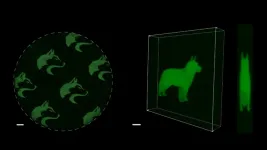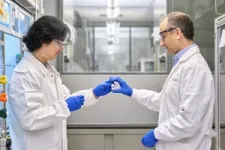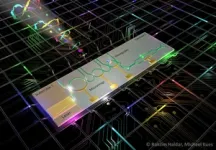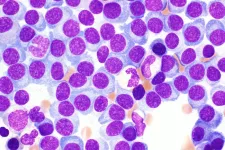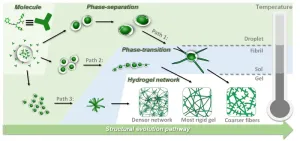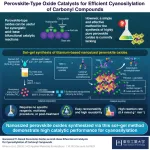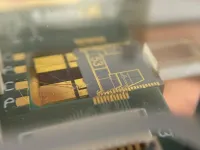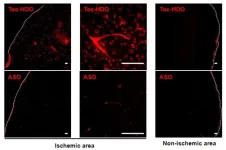(Press-News.org) Scientists can now use light to activate protein functions both inside and outside of living cells. The new method, called light-activated SpyLigation, can turn on proteins that are normally off to allow researchers to study and control them in more detail. This technology has potential uses in tissue engineering, regenerative medicine, and understanding how the body works.
Proteins perform nearly every important task in biology, including processing DNA, metabolizing nutrients, and fighting off infections. When, where, and how proteins become active is important for a variety of biological processes. Increasingly, scientists are also exploring whether protein functions can be turned on and off to treat disease.
“With new tools for controlling protein function, particularly those that offer controlled activation in time and space, we are working towards engineering complex tissue for transplantation,” said senior author Cole A. DeForest, a Weyerhaeuser Endowed Associate Professor of Chemical Engineering at the University of Washington College of Engineering and an associate professor of bioengineering, a joint department at the UW College of Engineering and School of Medicine.
“Since many more people could benefit from tissue or organ transplants than there are available donors," he said, "these methods offer real promise in combating the organ shortage crisis.”
As reported April 17 in the journal Nature Chemistry, a team led by Emily Ruskowitz and Brizzia Munoz-Robles from the DeForest Research Group has shown that chemically modified protein fragments can be joined together into functional wholes using brief flashes of light.
The scientists applied their new method to control the glow of a green fluorescent protein derived from Japanese eel muscle. Inactive fragments of that protein were blended and set into a Jell-O-like gel. Then lasers were used to irreversibly recombine those fragments into complete, glowing proteins. By controlling the path of the laser, a precise pattern of glowing proteins could be formed. The scientists etched microscopic images of a husky, their university mascot, into the gel. They also used lasers to create a glowing 3D image of a dog not much taller than a human hair.
The team also showed they could activate proteins inside human cells. Three minutes of light exposure was enough to turn on specific proteins involved in genome editing. Such a tool could one day be used to direct genetic changes to very specific areas of the body.
Similar to so-called click chemistry, which was the subject of the 2022 Nobel Prize in Chemistry, light-activated SpyLigation allows modified proteins to react with one another inside living systems. Extending beyond prior approaches, however, the new method allows for precise control over when and where such chemical reactions occur.
This work was supported by a CAREER Award (DMR 1652141) and grants (DMR 1807398, CBET 1803054), from the National Science Foundation, as well as a Maximizing Investigators’ Research Award (R35GM138036) from the National Institutes of Health. Student fellowship support was provided by the Institute for Stem Cells & Regenerative Medicine, and the Mary Gates Endowment for Students at the University of Washington. Part of this work was conducted with instrumentation provided by the Joint Center for Deployment and Research in Earth Abundant Materials. The Thorlabs multiphoton microscope was acquired with and operated under support from the Washington Research Foundation, UW College of Engineering, UW Medicine Institute for Stem Cells and Regenerative Medicine, and the UW chemical engineering, bioengineering, chemistry, and biology departments.
DeForest is an investigator at UW Medicine's Institute for Protein Design and Institute for Stem Cell and Regenerative Medicine, and the UW Molecular Engineering & Science Institute.
Written by Ian Haydon, UW Medicine Institute for Protein Design
END
SpyLigation uses light to switch on proteins
This light-activation technology has potential applications in tissue engineering, regenerative medicine, and understanding how the body works
2023-04-17
ELSE PRESS RELEASES FROM THIS DATE:
Dexamethasone for inpatients with COVID-19 in a national cohort
2023-04-17
About The Study: In this national multicenter cohort study of inpatients with COVID-19, early administration of dexamethasone was associated with significantly reduced odds of mortality or discharge to hospice in those requiring supplemental oxygen or mechanical ventilation and/or extracorporeal membrane oxygenation but not in those requiring no supplemental oxygen or noninvasive positive pressure ventilation. These results support the continued use of systemic dexamethasone in patients hospitalized with COVID-19.
Authors: Laine ...
Investigational drug may improve stem cell transplantation for multiple myeloma patients
2023-04-17
The standard treatment for patients with multiple myeloma often includes stem cell transplantation in which the patient’s own stem cells are harvested and stored while the patient receives intensive chemotherapy to kill the cancer. Then, the patient’s stem cells are returned to the patient to help with recovery. But for a significant proportion of patients, the number of stem cells that can be harvested is not optimal for transplant and negatively affects patient outcomes.
However, an international phase 3 clinical trial led by physicians at Washington University School of Medicine in St. Louis has shown that the investigational ...
University of Rochester researchers discover how to steer army of immune cells toward cancer
2023-04-17
Immunotherapy, particularly CAR T-Cell treatment for cancer, is extending the lives of many patients. But sometimes the therapy randomly migrates to places it shouldn’t go, tucking into the lungs or other noncancerous tissue and causing toxic side effects. A University of Rochester/Wilmot Cancer Institute team discovered the molecule responsible for guiding T cells toward tumors, setting the stage for scientists to improve upon the groundbreaking treatment.
The next step is to find a drug that can manipulate the ...
Poverty is the fourth greatest cause of U.S. deaths, analysis published in JAMA finds.
2023-04-17
Poverty has long been linked to shorter lives. But just how many deaths in the United States are associated with poverty? The number has been elusive – until now.
UC Riverside paper published Monday in the Journal of the American Medical Association associated poverty with an estimated 183,000 deaths in the United States in 2019 among people 15 years and older.
This estimate is considered conservative because the data is from the year just prior to the COVID-19 pandemic, which caused spikes in deaths worldwide and continues to take its toll.
The analysis found that only heart disease, ...
Steering phase-separated droplets to control mechanical properties of supramolecular peptide hydrogels
2023-04-17
Self-assembled peptide supramolecular hydrogels have shown great application prospects in various areas, including tissue engineering, drug delivery, and biosensing.
Precisely and flexibly controlling the mechanical properties of peptide hydrogels to match the targeted applications is important. The common methods to regulate the mechanical properties of supramolecular hydrogels generally include: changing the formula (different peptide sequences, adding cross-linking agents) or changing the environmental conditions (concentration, temperature, pH and ions), both of which inevitably change the chemical composition of the ...
Facile synthesis of high-performance perovskite oxides for acid–base catalysis
2023-04-17
Bifunctional acid−base catalysts are highly desirable for industrially relevant chemical processes. Owing to their ability to activate electrophiles and nucleophiles simultaneously, they allow the catalysis to proceed synergistically and cooperatively. Solid acid−base catalysts are particularly advantageous since they are reusable and result in no waste products. However, controlling the structure of such catalysts for cooperatively workable active sites is challenging. Simple and effective methods that enable the synthesis of high-performance solid acid−base ...
Quantum light source goes fully on-chip, bringing scalability to the quantum cloud
2023-04-17
An international team of researchers from Leibniz University Hannover (Germany), the University of Twente (Netherlands), and the start-up company QuiX Quantum has presented an entangled quantum light source fully integrated for the first time on a chip. “Our breakthrough allowed us to shrink the source size by a factor of more than 1000, allowing reproducibility, stability over a longer time, scaling, and potentially mass-production. All these characteristics are required for real-world applications such as quantum processors,” says Prof. Dr. Michael Kues, head of the Institute ...
Lipid molecules help to get stroke therapies into the brain
2023-04-17
Researchers from Tokyo Medical and Dental University (TMDU) find that, when a stroke therapy is linked to a specific kind of lipid and injected into the blood, it is taken up preferentially in the stroke-lesioned brain
Tokyo, Japan – To get therapies into the brain after a stroke, researchers are increasingly making use of the blood–brain barrier, which allows only certain molecules to pass from the blood into the brain. In a study published earlier this year in Molecular Therapy, ...
Ben-Gurion University researcher and colleagues pen 10 simple rules for socially responsible science
2023-04-17
BEER-SHEVA, Israel, April 17, 2023 – Scientific research must meet clear ethical guidelines to prevent harm to participants. However, research can also indirectly harm individuals and social groups, for example by shaping social perceptions and inspiring policy. Researchers receive little to no training on how to consider and minimize such harm.
To that end, Ben-Gurion University of the Negev's Dr. Niv Reggev and his international colleagues have published ten simple rules for socially responsible science. The ...
New approach estimates long-term coastal cliff loss
2023-04-17
In parts of California’s iconic mountainous coasts, breathtaking beauty is punctuated by brusque signs warning spectators to stay back from unstable cliffs. The dangers of coastal erosion are an all-too-familiar reality for the modern residents of these communities. Now, with a new tool, researchers are bringing historical perspective to the hotly debated topic of how to manage these disappearing coastlines.
Using a model that incorporates measurements of the amount of time coastal cliffs and their remnant deposits were exposed at the Earth’s surface, Stanford researchers found that the rate of cliff erosion in the past 100 years is ...
LAST 30 PRESS RELEASES:
Norbert Holtkamp appointed director of Fermi National Accelerator Laboratory
New agentic AI platform accelerates advanced optics design
Biologists discover neurons use physical signals — not electricity — to stabilize communication
Researchers discover that a hormone can access the brain by hitchhiking
University of Oklahoma researcher awarded funding to pursue AI-powered material design
Exploring how the visual system recovers following injury
Support for parents with infants at pediatric check-ups leads to better reading and math skills in elementary school
Kids’ behavioral health is a growing share of family health costs
Day & night: Cancer disrupts the brain’s natural rhythm
COVID-19 vaccination significantly reduces risk to pregnant women and baby
The role of vaccination in maternal and perinatal outcomes associated with COVID-19 in pregnancy
Mayo Clinic smartwatch system helps parents shorten and defuse children's severe tantrums early
Behavioral health spending spikes to 40% of all children’s health expenditures, nearly doubling in a decade
Digital cognitive behavioral treatment for generalized anxiety disorder
Expenditures for pediatric behavioral health care over time and estimated family financial burden
Air conditioning in nursing homes and mortality during extreme heat
The Alps to lose a record number of glaciers in the next decade
What makes a good proton conductor?
New science reporting guide published for journalists in Bulgaria
New international study reveals major survival gaps among children with cancer
New science reporting guide published for journalists in Turkey
Scientists develop a smarter mRNA therapy that knows which cells to target
Neuroanatomy-informed brain–machine hybrid intelligence for robust acoustic target detection
Eight SwRI hydrogen projects funded by ENERGYWERX
The Lundquist Institute and its start-up company Vitalex Biosciences Announces Strategic Advancement of Second-Generation fungal Vaccine VXV-01 through Phase 1 Trials under $40 Million Competitive Con
Fine particles in pollution are associated with early signs of autoimmune disease
Review article | Towards a Global Ground-Based Earth Observatory (GGBEO): Leveraging existing systems and networks
Penn and UMich create world’s smallest programmable, autonomous robots
Cleveland researchers launch first major study to address ‘hidden performance killer’ in athletes
To connect across politics, try saying what you oppose
[Press-News.org] SpyLigation uses light to switch on proteinsThis light-activation technology has potential applications in tissue engineering, regenerative medicine, and understanding how the body works
